Improving Air-Stability and Performance of Bulk Heterojunction Polymer Solar Cells Using Solvent Engineered Hole Selective Interlayer
Abstract
1. Introduction
2. Materials and Methods
2.1. Materials and HSIL Preparation
2.2. Fabrication and Characterization of the BHJ-PSCs
2.3. Thin Film Characterization
3. Results
3.1. Photovoltaic Performance
3.2. Microstructural Properties
3.3. Surface Properties
3.4. Electronic Property
3.5. Air-Stability
4. Conclusions
Supplementary Materials
Author Contributions
Funding
Conflicts of Interest
References
- Li, G.; Zhu, R.; Yang, Y. Polymer solar cells. Nat. Photonics 2012, 6, 153. [Google Scholar] [CrossRef]
- Zhang, Z.; Li, X.; Guan, G.; Pan, S.; Zhu, Z.; Ren, D.; Peng, H. A lightweight polymer solar cell textile that functions when illuminated from either side. Angew. Chem. Int. Ed. 2014, 53, 11571–11574. [Google Scholar] [CrossRef] [PubMed]
- Sun, C.; Pan, F.; Bin, H.; Zhang, J.; Xue, L.; Qiu, B.; Wei, Z.; Zhang, Z.-G.; Li, Y. A low cost and high performance polymer donor material for polymer solar cells. Nat. Commun. 2018, 9, 743. [Google Scholar] [CrossRef] [PubMed]
- An, Q.; Zhang, F.; Zhang, J.; Tang, W.; Deng, Z.; Hu, B. Versatile ternary organic solar cells: A critical review. Energy Environ. Sci. 2016, 9, 281–322. [Google Scholar] [CrossRef]
- Zhao, W.; Qian, D.; Zhang, S.; Li, S.; Inganäs, O.; Gao, F.; Hou, J. Fullerene-free polymer solar cells with over 11% efficiency and excellent thermal stability. Adv. Mater. 2016, 28, 4734–4739. [Google Scholar] [CrossRef] [PubMed]
- Xiao, B.; Wu, H.; Cao, Y. Solution-processed cathode interfacial layer materials for high-efficiency polymer solar cells. Mater. Today 2015, 18, 385–394. [Google Scholar] [CrossRef]
- Zeng, H.; Zhu, X.; Liang, Y.; Guo, X. Interfacial layer engineering for performance enhancement in polymer solar cells. Polymers 2015, 7, 333–372. [Google Scholar] [CrossRef]
- Zhang, K.; Liu, X.-Y.; Xu, B.-W.; Cui, Y.; Sun, M.-L.; Hou, J.-H. High-performance fullerene-free polymer solar cells with solution-processed conjugated polymers as anode interfacial layer. Chin. J. Polym. Sci. 2017, 35, 219–229. [Google Scholar] [CrossRef]
- Glen, T.S.; Scarratt, N.W.; Yi, H.; Iraqi, A.; Wang, T.; Kingsley, J.; Buckley, A.R.; Lidzey, D.G.; Donald, A.M. Dependence on material choice of degradation of organic solar cells following exposure to humid air. J. Polym. Sci. Part B Polym. Phys. 2016, 54, 216–224. [Google Scholar] [CrossRef] [PubMed]
- Manzano-Ramírez, A.; López-Naranjo, E.J.; Soboyejo, W.; Meas-Vong, Y.; Vilquin, B. A review on the efficiency of graphene-based bhj organic solar cells. J. Nanomater. 2015, 2015, 15. [Google Scholar] [CrossRef]
- Wang, X.; Zhao, C.X.; Xu, G.; Chen, Z.-K.; Zhu, F. Degradation mechanisms in organic solar cells: Localized moisture encroachment and cathode reaction. Sol. Energy Mater. Sol. Cells 2012, 104, 1–6. [Google Scholar] [CrossRef]
- Hu, Z.; Zhang, J.; Hao, Z.; Zhao, Y. Influence of doped pedot: Pss on the performance of polymer solar cells. Sol. Energy Mater. Sol. Cells 2011, 95, 2763–2767. [Google Scholar] [CrossRef]
- Hou, X.; Li, Q.; Cheng, T.; Yu, L.; Wang, F.; Lin, J.; Dai, S.; Li, Y.; Tan, Z.A. Improvement of the power conversion efficiency and long term stability of polymer solar cells by incorporation of amphiphilic nafion doped pedot-pss as a hole extraction layer. J. Mater. Chem. A 2015, 3, 18727–18734. [Google Scholar] [CrossRef]
- Lattante, S. Electron and hole transport layers: Their use in inverted bulk heterojunction polymer solar cells. Electronics 2014, 3, 132–164. [Google Scholar] [CrossRef]
- Savva, A.; Georgiou, E.; Papazoglou, G.; Chrusou, A.Z.; Kapnisis, K.; Choulis, S.A. Photovoltaic analysis of the effects of pedot:Pss-additives hole selective contacts on the efficiency and lifetime performance of inverted organic solar cells. Sol. Energy Mater. Sol. Cells 2015, 132, 507–514. [Google Scholar] [CrossRef]
- Wang, M.; Zhou, M.; Zhu, L.; Li, Q.; Jiang, C. Enhanced polymer solar cells efficiency by surface coating of the pedot: Pss with polar solvent. Sol. Energy 2016, 129, 175–183. [Google Scholar] [CrossRef]
- Nagata, R.; Yanagi, Y.; Fujii, S.; Kataura, H.; Nishioka, Y. Application of highly conductive dmso-treated pedot:Pss electrodes to flexible organic solar cells. In Proceedings of the 2014 21st International Workshop on Active-Matrix Flatpanel Displays and Devices (AM-FPD), Kyoto, Japan, 2–4 July 2014; pp. 299–302. [Google Scholar]
- Keawprajak, A.; Koetniyom, W.; Piyakulawat, P.; Jiramitmongkon, K.; Pratontep, S.; Asawapirom, U. Effects of tetramethylene sulfone solvent additives on conductivity of pedot:Pss film and performance of polymer photovoltaic cells. Org. Electron. 2013, 14, 402–410. [Google Scholar] [CrossRef]
- Yang, J.S.; Oh, S.H.; Kim, D.L.; Kim, S.J.; Kim, H.J. Hole transport enhancing effects of polar solvents on poly(3,4-ethylenedioxythiophene):Poly(styrene sulfonic acid) for organic solar cells. ACS Appl. Mater. Interfaces 2012, 4, 5394–5398. [Google Scholar] [CrossRef] [PubMed]
- Hu, Z.; Zhang, J.; Zhu, Y. Effects of solvent-treated pedot: Pss on organic photovoltaic devices. Renew. Energy 2014, 62, 100–105. [Google Scholar] [CrossRef]
- Zhang, C.; Cheng, J.; Liao, X.; Lian, X.; Zhang, J.; Yang, X.; Li, L. Investigation of poly(3,4-ethylenedioxythiophene):Poly(styrenesulfonate) hole transport layer for solution-processed polymer solar cells. Int. J. Photoenergy 2015, 2015, 7. [Google Scholar] [CrossRef] [PubMed]
- Chen, C.-H.; LaRue, J.C.; Nelson, R.D.; Kulinsky, L.; Madou, M.J. Electrical conductivity of polymer blends of poly(3,4-ethylenedioxythiophene): Poly(styrenesulfonate): N-methyl-2-pyrrolidinone and polyvinyl alcohol. J. Appl. Polym. Sci. 2012, 125, 3134–3141. [Google Scholar] [CrossRef]
- Li, Q.; Yang, J.; Chen, S.; Zou, J.; Xie, W.; Zeng, X. Highly conductive pedot: Pss transparent hole transporting layer with solvent treatment for high performance silicon/organic hybrid solar cells. Nanoscale Res. Lett. 2017, 12, 506. [Google Scholar] [CrossRef] [PubMed]
- Ouyang, J.; Xu, Q.F.; Chu, C.W.; Yang, Y.; Li, G.; Shinar, J. On the mechanism of conductivity enhancement in poly (3,4-ethylenedioxythiophene): Poly(styrene sulfonate) film through solvent treatment. Polymer 2004, 45, 8443–8450. [Google Scholar] [CrossRef]
- Xu, B.; Gopalan, S.-A.; Gopalan, A.-I.; Muthuchamy, N.; Lee, K.-P.; Lee, J.-S.; Jiang, Y.; Lee, S.-W.; Kim, S.-W.; Kim, J.-S.; et al. Functional solid additive modified pedot:Pss as an anode buffer layer for enhanced photovoltaic performance and stability in polymer solar cells. Sci. Rep. 2017, 7, 45079. [Google Scholar] [CrossRef] [PubMed]
- Gopalan, S.-A.; Seo, M.-H.; Anantha-Iyengar, G.; Han, B.; Lee, S.-W.; Kwon, D.-H.; Lee, S.-H.; Kang, S.-W. Mild wetting poor solvent induced hydrogen bonding interactions for improved performance in bulk heterojunction solar cells. J. Mater. Chem. A 2014, 2, 2174–2186. [Google Scholar] [CrossRef]
- Sai-Anand, G.; Gopalan, A.-I.; Lee, K.-P.; Venkatesan, S.; Kang, B.-H.; Lee, S.-W.; Lee, J.-S.; Qiao, Q.; Kwon, D.-H.; Kang, S.-W. A futuristic strategy to influence the solar cell performance using fixed and mobile dopants incorporated sulfonated polyaniline based buffer layer. Sol. Energy Mater. Sol. Cells 2015, 141, 275–290. [Google Scholar] [CrossRef]
- Xu, B.; Sai-Anand, G.; Gopalan, A.-I.; Qiao, Q.; Kang, S.-W. Improving photovoltaic properties of p3ht:Ic60ba through the incorporation of small molecules. Polymers 2018, 10, 121. [Google Scholar] [CrossRef]
- Seemann, A.; Egelhaaf, H.J.; Brabec, C.; Hauch, J.A. Influence of Oxygen on Semi-Transparent Organic Solar Cells with Gas Permeable Electrodes. Org. Electron. 2009, 10, 1424–1428. [Google Scholar] [CrossRef]
- Norrman, K.; Gevorgyan, S.A.; Krebs, F.C. Water-induced degradation of polymer solar cells studied by h218o labeling. ACS Appl. Mater. Interfaces 2009, 1, 102–112. [Google Scholar] [CrossRef] [PubMed]
- Reese, M.O.; Morfa, A.J.; White, M.S.; Kopidakis, N.; Shaheen, S.E.; Rumbles, G.; Ginley, D.S. Pathways for the degradation of organic photovoltaic p3ht:Pcbm based devices. Sol. Energy Mater. Sol. Cells 2008, 92, 746–752. [Google Scholar] [CrossRef]
- Chen, Y.; Sun, Y.; Yu, C.; Li, F.; Wang, Y. Anode engineering of highly efficient polymer solar cells using treated ito. Chem. Res. Chin. Univ. 2016, 32, 689–694. [Google Scholar] [CrossRef]
- Alemu Mengistie, D.; Wang, P.-C.; Chu, C.-W. Effect of molecular weight of additives on the conductivity of pedot:Pss and efficiency for ito-free organic solar cells. J. Mater. Chem. A 2013, 1, 9907–9915. [Google Scholar] [CrossRef]
- Zhao, L.; Zhao, S.; Xu, Z.; Huang, D.; Zhao, J.; Li, Y.; Xu, X. The effects of improved photoelectric properties of pedot:Pss by two-step treatments on the performance of polymer solar cells based on ptb7-th:Pc71bm. ACS Appl. Mater. Interfaces 2016, 8, 547–552. [Google Scholar] [CrossRef] [PubMed]
- Peng, B.; Guo, X.; Cui, C.; Zou, Y.; Pan, C.; Li, Y. Performance improvement of polymer solar cells by using a solvent-treated poly(3,4-ethylenedioxythiophene):Poly(styrenesulfonate) buffer layer. Appl. Phys. Lett. 2011, 98, 243308. [Google Scholar] [CrossRef]
- Li, Z.; Meng, W.; Tong, J.; Zhao, C.; Qin, F.; Jiang, F.; Xiong, S.; Zeng, S.; Xu, L.; Hu, B.; et al. A nonionic surfactant simultaneously enhancing wetting property and electrical conductivity of pedot: Pss for vacuum-free organic solar cells. Sol. Energy Mater. Sol. Cells 2015, 137, 311–318. [Google Scholar] [CrossRef]
- Singh, V.; Arora, S.; Arora, M.; Sharma, V.; Tandon, R.P. Characterization of doped pedot: Pss and its influence on the performance and degradation of organic solar cells. Semicond. Sci. Technol. 2014, 29, 045020. [Google Scholar] [CrossRef]
- Kara, M.O.P.; Frey, M.W. Effects of solvents on the morphology and conductivity of poly(3,4-ethylenedioxythiophene):Poly(styrenesulfonate) nanofibers. J. Appl. Polym. Sci. 2014, 131. [Google Scholar] [CrossRef]
- Cho, W.; Im, S.; Kim, S.; Kim, S.; Kim, J. Synthesis and characterization of pedot:P(ss-co-vtms) with hydrophobic properties and excellent thermal stability. Polymers 2016, 8, 189. [Google Scholar] [CrossRef]
- Li, J.; Liu, J.; Gao, C.; Zhang, J.; Sun, H. Influence of mwcnts doping on the structure and properties of pedot:Pss films. Int. J. Photoenergy 2009, 2009, 1–5. [Google Scholar] [CrossRef]
- Chou, T.-R.; Chen, S.-H.; Chiang, Y.-T.; Lin, Y.-T.; Chao, C.-Y. Highly conductive pedot:Pss films by post-treatment with dimethyl sulfoxide for ito-free liquid crystal display. J. Mater. Chem. C 2015, 3, 3760–3766. [Google Scholar] [CrossRef]
- Xiong, S.; Zhang, L.; Lu, X. Conductivities enhancement of poly(3,4-ethylenedioxythiophene)/poly(styrene sulfonate) transparent electrodes with diol additives. Polym. Bull. 2012, 70, 237–247. [Google Scholar] [CrossRef]
- Farah, A.A.; Rutledge, S.A.; Schaarschmidt, A.; Lai, R.; Freedman, J.P.; Helmy, A.S. Conductivity enhancement of poly(3,4-ethylenedioxythiophene)-poly(styrenesulfonate) films post-spincasting. J. Appl. Phys. 2012, 112, 113709. [Google Scholar] [CrossRef]
- Zhu, Z.; Song, H.; Xu, J.; Liu, C.; Jiang, Q.; Shi, H. Significant conductivity enhancement of pedot:Pss films treated with lithium salt solutions. J. Mater. Sci. Mater. Electron. 2015, 26, 429–434. [Google Scholar] [CrossRef]
- Sai-Anand, G.; Han, B.; Kang, B.-H.; Kim, S.-W.; Lee, S.-W.; Lee, J.-S.; Jeong, H.-M.; Kang, S.-W. Incorporation of gold nanodots into poly(3,4-ethylenedioxythiophene):Poly(styrene sulfonate) for an efficient anode interfacial layer for improved plasmonic organic photovoltaics. J. Nanosci. Nanotechnol. 2015, 15, 7092–7098. [Google Scholar] [CrossRef] [PubMed]
- Ouyang, L.; Musumeci, C.; Jafari, M.J.; Ederth, T.; Inganäs, O. Imaging the phase separation between pedot and polyelectrolytes during processing of highly conductive pedot: Pss films. ACS Appl. Mater. Interfaces 2015, 7, 19764–19773. [Google Scholar] [CrossRef] [PubMed]
- Takeya, U.; Muneki, Y.; Arao, N.; Hideo, K. Segmentation of conducting domains in pedot:Pss films induced by an additive for conductivity enhancement. Appl. Phys. Express 2016, 9, 051601. [Google Scholar]
- Thomas, J.P.; Zhao, L.; McGillivray, D.; Leung, K.T. High-efficiency hybrid solar cells by nanostructural modification in pedot:Pss with co-solvent addition. J. Mater. Chem. A 2014, 2, 2383–2389. [Google Scholar] [CrossRef]
- Araźna, A.; Janeczek, K.; Futera, K.; Koziol, A. Modification of conductive polymer PEDOT:PSS layer by SWCNT. IOP Conf. Ser. Mater. Sci. Eng. 2016, 104, 012027. [Google Scholar]
- Sai-Anand, G.; Dubey, A.; Gopalan, A.-I.; Venkatesan, S.; Ruban, S.; Reza, K.M.; Choi, J.; Lakhi, K.S.; Xu, B.; Qiao, Q.; et al. Additive assisted morphological optimization of photoactive layer in polymer solar cells. Sol. Energy Mater. Sol. Cells 2018, 182, 246–254. [Google Scholar] [CrossRef]
- Deetuam, C.; Weise, D.; Samthong, C.; Praserthdam, P.; Baumann, R.R.; Somwangthanaroj, A. Electrical conductivity enhancement of spin-coated pedot:Pss thin film via dipping method in low concentration aqueous dmso. J. Appl. Polym. Sci. 2015, 132. [Google Scholar] [CrossRef]
- Zhu, Q.; Bao, X.; Yu, J.; Yang, R.; Dong, L. Simple synthesis of solution-processable oxygen-enriched graphene as anode buffer layer for efficient organic solar cells. Org. Electron. 2015, 27, 143–150. [Google Scholar] [CrossRef]
- Sai-Anand, G.; Gopalan, A.-I.; Lee, K.-P.; Venkatesan, S.; Qiao, Q.; Kang, B.-H.; Lee, S.-W.; Lee, J.-S.; Kang, S.-W. Electrostatic nanoassembly of contact interfacial layer for enhanced photovoltaic performance in polymer solar cells. Sol. Energy Mater. Sol. Cells 2016, 153, 148–163. [Google Scholar] [CrossRef]
- Cellot, G.; Lagonegro, P.; Tarabella, G.; Scaini, D.; Fabbri, F.; Iannotta, S.; Prato, M.; Salviati, G.; Ballerini, L. Pedot: Pss interfaces support the development of neuronal synaptic networks with reduced neuroglia response in vitro. Front. Neurosci. 2016, 9, 521. [Google Scholar] [CrossRef] [PubMed]
- Gopalan, S.-A.; Gopalan, A.-I.; Vinu, A.; Lee, K.-P.; Kang, S.-W. A new optical-electrical integrated buffer layer design based on gold nanoparticles tethered thiol containing sulfonated polyaniline towards enhancement of solar cell performance. Sol. Energy Mater. Sol. Cells 2018, 174, 112–123. [Google Scholar] [CrossRef]
- Xing, Y.-J.; Qian, M.-F.; Guo, D.-Z.; Zhang, G.-M. Increased work function in pedot: Pss film under ultraviolet irradiation. Chin. Phys. B 2014, 23, 038504. [Google Scholar] [CrossRef]
- Hwang, J.; Amy, F.; Kahn, A. Spectroscopic study on sputtered pedot·pss: Role of surface pss layer. Org. Electron. 2006, 7, 387–396. [Google Scholar] [CrossRef]
- Vida, T.; Sebastian, E.; Nikos, T.; Harald, H.; Morten, M.; Horst-Günter, R.; Uwe, R.; Gerhard, G. Long-term stabilization of organic solar cells using uv absorbers. J. Phys. D Appl. Phys. 2016, 49, 125604. [Google Scholar]
- Zhang, Y.; Chen, L.; Hu, X.; Zhang, L.; Chen, Y. Low work-function poly(3,4-ethylenedioxylenethiophene): Poly(styrene sulfonate) as electron-transport layer for high-efficient and stable polymer solar cells. Sci. Rep. 2015, 5, 12839. [Google Scholar] [CrossRef] [PubMed]
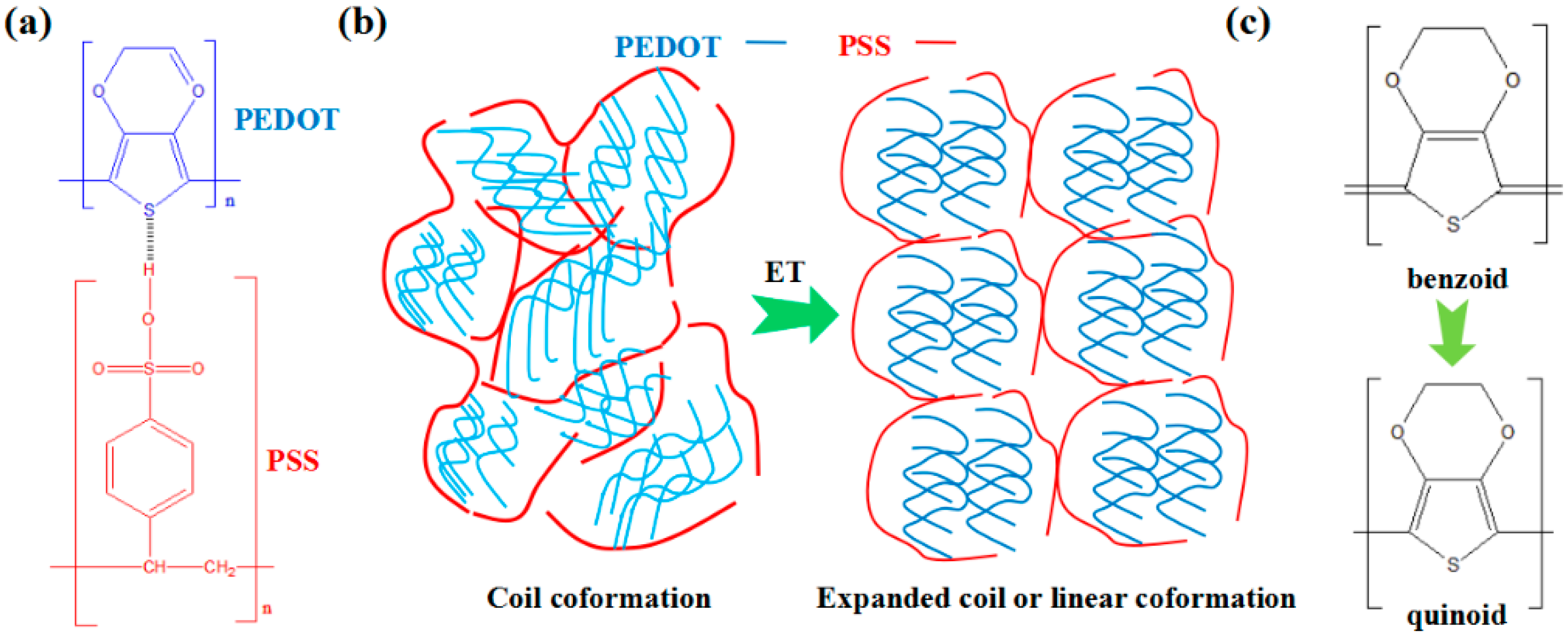
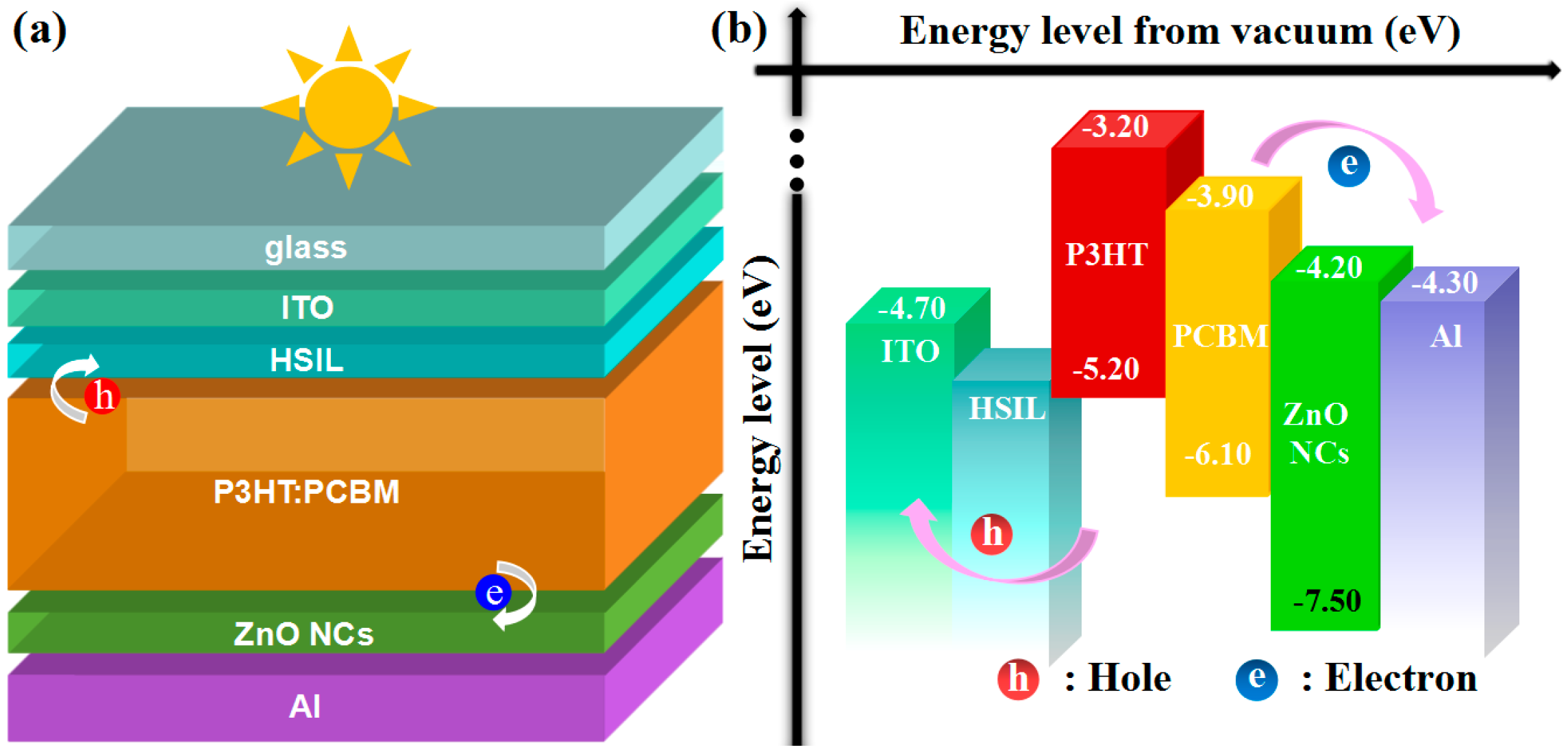
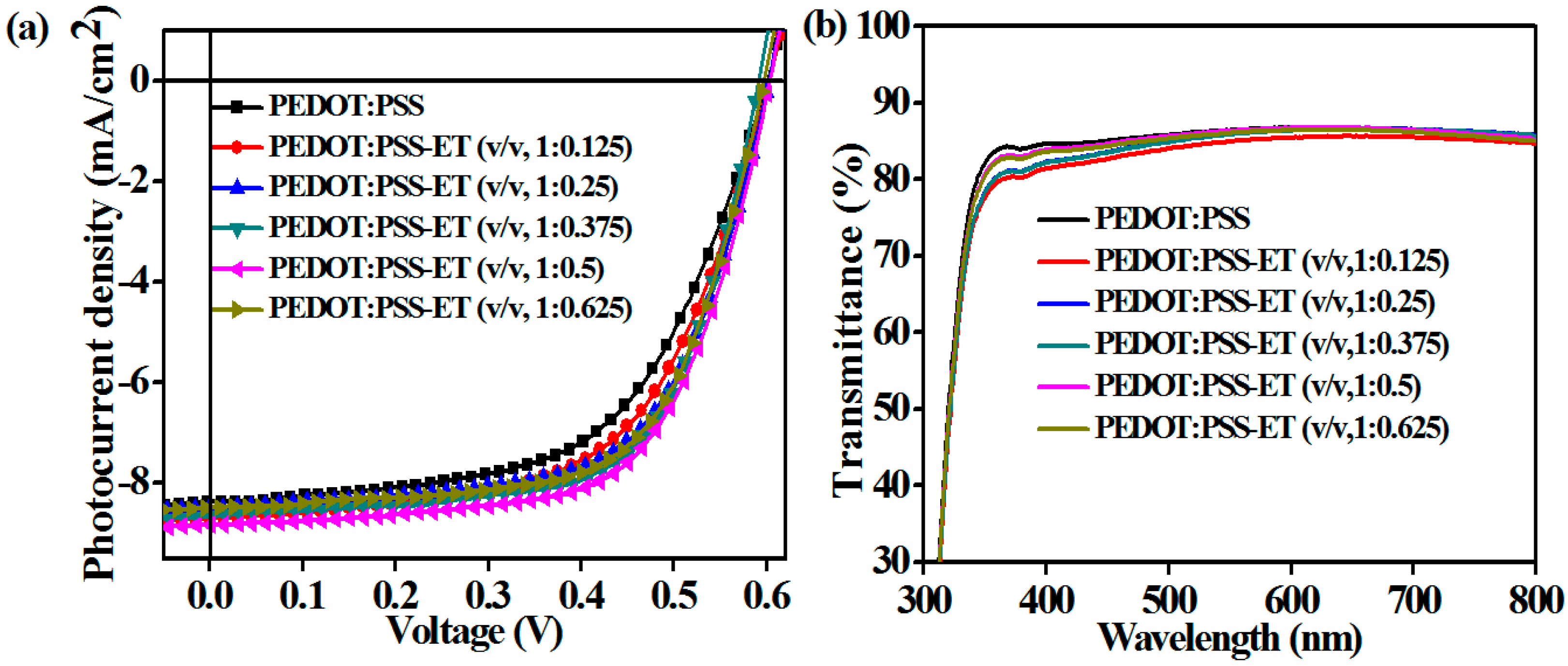

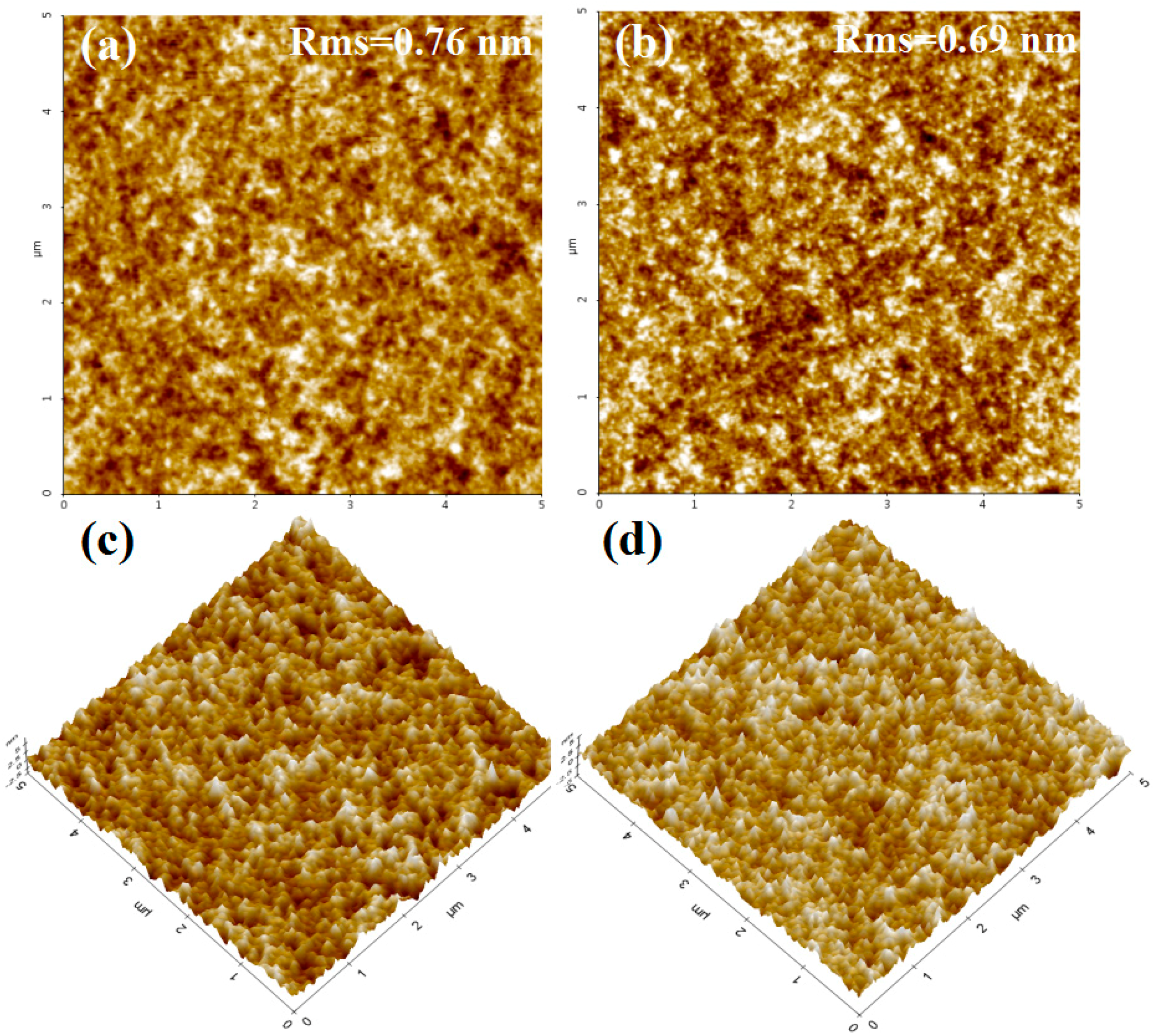
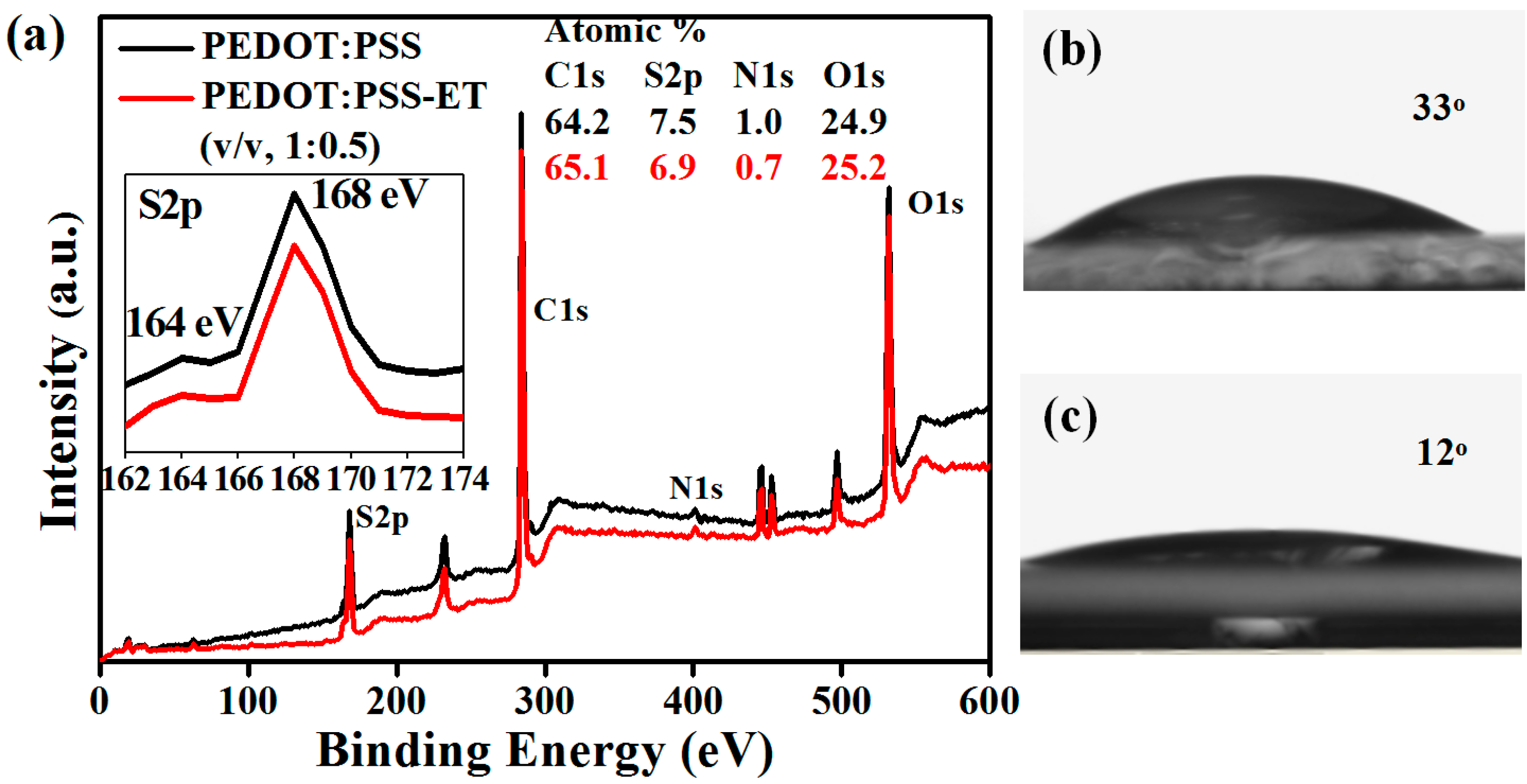
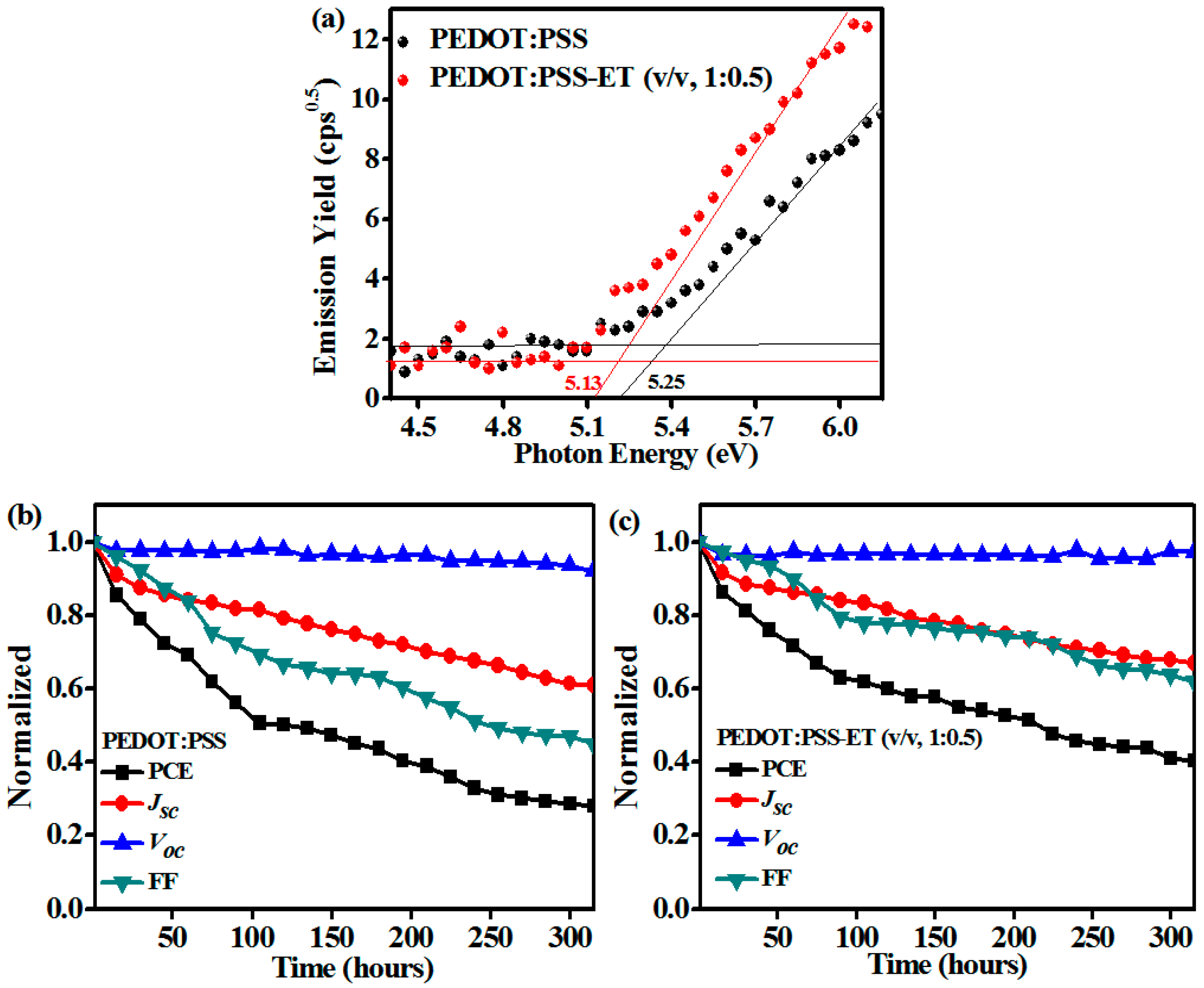
| HSIL | Voc (V) | Jsc (mA/cm2) | Rs (Ω) | FF | PCEa (%) | PCEb (%) |
|---|---|---|---|---|---|---|
| pristine | 0.59 ± 0.006 | 8.376 ± 0.07 | 241 ± 9.3 | 0.58 ± 0.016 | 2.92 | 2.86 ± 0.094 |
| 1:0.125 | 0.59 ± 0.004 | 8.421 ± 0.04 | 195 ± 8.5 | 0.59 ± 0.006 | 3.10 | 3.08 ± 0.012 |
| 1:0.25 | 0.60 ± 0.004 | 8.565 ± 0.03 | 170 ± 3.7 | 0.63 ± 0.005 | 3.22 | 3.21 ± 0.015 |
| 1:0.375 | 0.60 ± 0.004 | 8.652 ± 0.06 | 162 ± 4.6 | 0.63 ± 0.007 | 3.33 | 3.30 ± 0.016 |
| 1:0.5 | 0.60 ± 0.005 | 8.890 ± 0.05 | 155 ± 5.8 | 0.64 ± 0.004 | 3.42 | 3.36 ± 0.041 |
| 1:0.625 | 0.59 ± 0.005 | 8.572 ± 0.08 | 159 ± 6.4 | 0.63 ± 0.005 | 3.27 | 3.22 ± 0.035 |
| PEDOT:PSS-ET (v/v) | pH Value |
|---|---|
| Pristine | 1.65 |
| 1:0.125 | 1.77 |
| 1:0.25 | 1.96 |
| 1:0.375 | 1.99 |
| 1:0.5 | 2.04 |
| 1:0.625 | 2.14 |
| ET | 6.87 |
© 2018 by the authors. Licensee MDPI, Basel, Switzerland. This article is an open access article distributed under the terms and conditions of the Creative Commons Attribution (CC BY) license (http://creativecommons.org/licenses/by/4.0/).
Share and Cite
Xu, B.; Sai-Anand, G.; Jeong, H.-M.; Kim, S.-W.; Kim, J.-S.; Kwon, J.-B.; Kang, S.-W. Improving Air-Stability and Performance of Bulk Heterojunction Polymer Solar Cells Using Solvent Engineered Hole Selective Interlayer. Materials 2018, 11, 1143. https://doi.org/10.3390/ma11071143
Xu B, Sai-Anand G, Jeong H-M, Kim S-W, Kim J-S, Kwon J-B, Kang S-W. Improving Air-Stability and Performance of Bulk Heterojunction Polymer Solar Cells Using Solvent Engineered Hole Selective Interlayer. Materials. 2018; 11(7):1143. https://doi.org/10.3390/ma11071143
Chicago/Turabian StyleXu, Binrui, Gopalan Sai-Anand, Hyun-Min Jeong, Sae-Wan Kim, Ju-Seong Kim, Jin-Beom Kwon, and Shin-Won Kang. 2018. "Improving Air-Stability and Performance of Bulk Heterojunction Polymer Solar Cells Using Solvent Engineered Hole Selective Interlayer" Materials 11, no. 7: 1143. https://doi.org/10.3390/ma11071143
APA StyleXu, B., Sai-Anand, G., Jeong, H.-M., Kim, S.-W., Kim, J.-S., Kwon, J.-B., & Kang, S.-W. (2018). Improving Air-Stability and Performance of Bulk Heterojunction Polymer Solar Cells Using Solvent Engineered Hole Selective Interlayer. Materials, 11(7), 1143. https://doi.org/10.3390/ma11071143






